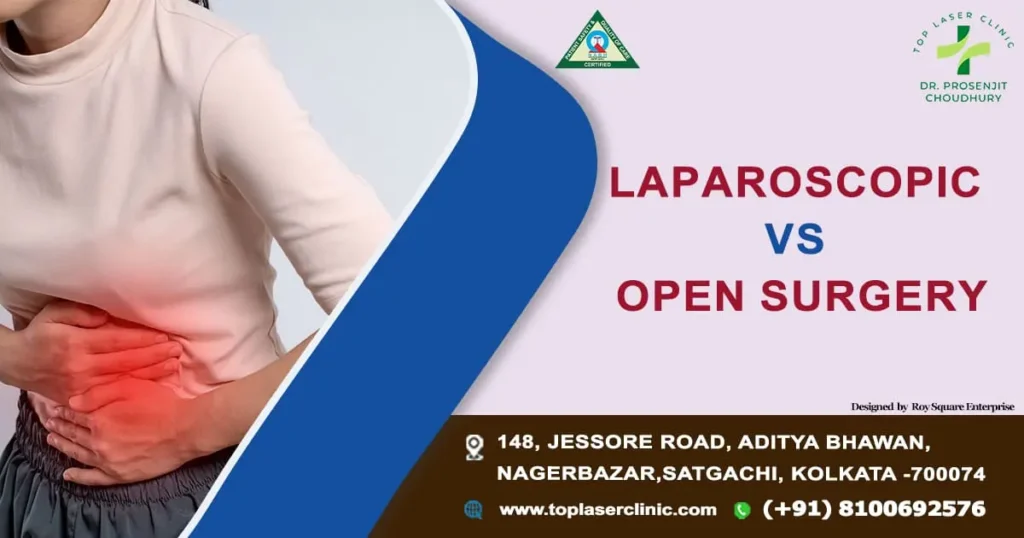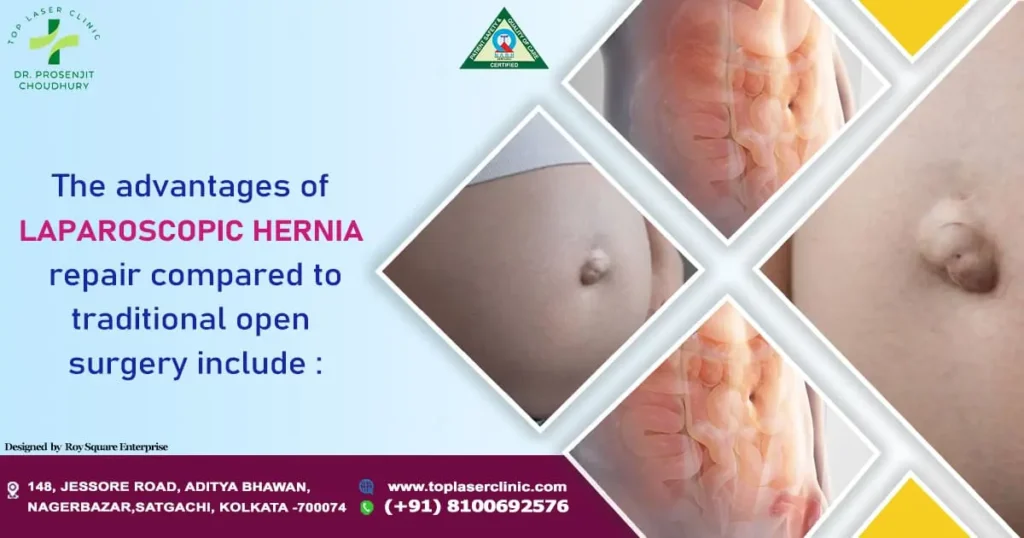Table of Contents
Laparoscopic Hernia

Laparoscopic hernia repair, also known as laparoscopic herniorrhaphy, is a minimally invasive surgical technique used to repair hernias. Hernias occur when an organ or tissue swells through a weak spot in the adjacent tissue or connective muscle.
During laparoscopic hernia repair, the surgeon makes several small incisions in the abdomen through which specialized surgical instruments and a tiny camera (laparoscope) are inserted. The camera provides a view of the internal structures on a monitor, allowing the surgeon to guide the instruments and perform the repair with precision.
The advantages of laparoscopic hernia repair compared to traditional open surgery include:
- Smaller incisions: Laparoscopic surgery requires only small incisions, which typically result in less scarring, reduced pain, and faster recovery.
- Reduced risk of complications: Because the incisions are smaller, there is generally less trauma to surrounding tissues, leading to a lower risk of complications such as infection and blood loss.
- Quicker recovery: Patients often experience a shorter hospital stay and a faster return to normal activities compared to open surgery.
- Improved cosmetic outcome: The smaller incisions result in less noticeable scars compared to the larger incision used in open surgery.
Know about the anatomy of Laproscopic Hernia
In laparoscopic hernia repair, understanding the anatomy of the hernia and surrounding structures is crucial for successful surgery. Laparoscopic hernia repair is suitable for many types of hernias, including inguinal hernias, femoral hernias, and some ventral hernias. However, not all hernias are appropriate for laparoscopic repair, and the decision on the surgical approach depends on various factors such as the size and location of the hernia, the patient’s overall health, and the surgeon’s expertise. It is crucial to get in touch with the healthcare personnel to determine the most accurate treatment option.
The anatomy involved varies depending on the type of hernia being repaired, but here’s a general overview:
- Inguinal Hernia:
• Inguinal hernias occur in the groin area when abdominal contents protrude through the inguinal canal, a passage in the lower abdominal wall.
• The inguinal canal comprises of the spermatic cord in males and the round ligament of the uterus in women.
• During laparoscopic repair, the surgeon typically identifies the hernia sac, reduces it back into the abdominal cavity, and reinforces the weakened area with mesh. - Femoral Hernia:
• Femoral hernias occur lower in the groin area, through the femoral canal, which lies just below the inguinal ligament.
• The femoral canal contains the femoral vein, artery, and lymphatic vessels.
• Like inguinal hernias, femoral hernias are repaired by reducing the hernia sac and reinforcing the area with mesh. - Ventral Hernia:
• Ventral hernias can occur anywhere on the anterior abdominal wall, often at sites of previous surgical incisions or weakened areas.
• These hernias may involve protrusion through the linea alba (the midline connective tissue of the abdominal wall) or other weak spots in the abdominal muscles.
• Laparoscopic repair involves identifying the hernia defect, reducing the hernia contents, and reinforcing the area with mesh.
During laparoscopic hernia repair, the surgeon uses a laparoscope to visualize the hernia defect and surrounding anatomy. Specialized instruments are used to dissect tissue, reduce hernia contents, and place mesh to strengthen the weakened area. The laparoscope provides magnified images of the operative field, allowing for precise surgical maneuvers while minimizing trauma to surrounding tissues.
Understanding the specific anatomy of each type of hernia is essential for the surgeon to perform laparoscopic hernia repair safely and effectively. Additionally, variations in anatomy among individuals may require adjustments in surgical technique to achieve optimal outcomes.
Understand the techniques:
TEP (Totally Extraperitoneal) and TAPP (Transabdominal Preperitoneal) are two common techniques used in laparoscopic inguinal hernia repair. Both techniques aim to repair inguinal hernias while minimizing trauma and promoting faster recovery.
Here’s a brief overview of each technique and the “triangle of pain” or “triangle of doom” associated with them:
- TEP (Totally Extraperitoneal):
• In the TEP approach, the surgeon accesses the hernia site through a small incision below the umbilicus (belly button) but above the pubic bone.
• The surgeon then creates a working space outside the peritoneum (the lining of the abdominal cavity) but inside the abdominal wall muscles.
• The hernia defect is repaired by placing a mesh patch over the weakened area to reinforce it.
• The “triangle of doom” refers to a potential risk area within the TEP approach. This triangle is formed by the inferior epigastric vessels (which supply blood to the lower abdomen) and the vas deferens (in men) or the round ligament of the uterus (in women). Injury to these structures within the triangle can lead to serious complications such as bleeding or damage to the spermatic cord or round ligament. - TAPP (Transabdominal Preperitoneal):
• In the TAPP approach, the surgeon enters the abdominal cavity through a small incision at the umbilicus and insufflates carbon dioxide gas to create space.
• The peritoneum (the lining of the abdominal cavity) is then incised, and the hernia site is accessed.
• The hernia defect is repaired similarly to TEP, with the placement of a mesh patch to reinforce the weakened area.
• The “triangle of pain” refers to a potential area of nerve entrapment or irritation that can occur within the TAPP approach. This triangle is formed by the iliopubic tract, the inguinal ligament and the spermatic cord (in men) or the round ligament of the uterus (in women). Entrapment or irritation of nerves within this triangle can lead to chronic pain or discomfort following surgery.
Both TEP and TAPP techniques have their advantages and disadvantages, and the choice between them depends on factors such as surgeon preference, patient anatomy, and the specific characteristics of the hernia. Surgeons must be aware of the potential risks associated with each technique, including the risk of injury or nerve entrapment within the “triangle of doom” or “triangle of pain.”
Laparoscopic VS Open Surgery
Laparoscopic and open surgery are two approaches used for hernia repair, each with its own set of advantages and disadvantages. Here’s a comparison of laparoscopic and open surgery for hernia repair:
Laparoscopic Hernia Repair:

Advantages:
- Minimally Invasive: Laparoscopic surgery involves making several small incisions through which specialized instruments and a camera are inserted. This minimally invasive approach typically results in less tissue trauma, reduced postoperative pain, and faster recovery.
- Shorter Hospital Stay: Patients undergoing laparoscopic hernia repair often have shorter hospital stays compared to open surgery.
- Quicker Recovery: Due to less tissue trauma, patients may recover more quickly and return to normal activities sooner.
- Cosmetic Outcome: The smaller incisions in laparoscopic surgery usually result in less noticeable scars compared to open surgery.
- Less Risk of Wound Complications: With smaller incisions, the risk of wound complications such as infection or hernia recurrence may be reduced.
Disadvantages:
- Technical Expertise Required: Laparoscopic hernia repair requires specialized training and expertise. Surgeons must be proficient in laparoscopic techniques to perform the procedure safely and effectively.
- Longer Operative Time: Laparoscopic surgery may take longer to perform compared to open surgery, especially for less experienced surgeons.
- Cost: Laparoscopic hernia repair can be more expensive than open surgery due to the need for specialized equipment and longer operative times.
Open Hernia Repair:
Advantages:
- Familiar Technique: Open hernia repair is a well-established technique that many surgeons are familiar with.
- Suitable for Complex Cases: Open surgery may be more suitable for complex hernias, large hernias, or cases with extensive scarring or adhesions.
- Lower Equipment Costs: Open surgery typically requires less specialized equipment compared to laparoscopic surgery, potentially reducing overall costs.
- Less Technical Skill Required: While open hernia repair still requires skill and expertise, it may be more accessible to surgeons who are not trained in laparoscopic techniques.
Disadvantages:

- More Invasive: Open surgery involves a larger incision, resulting in more tissue trauma and potentially more postoperative pain.
- Longer Recovery Time: Patients undergoing open hernia repair may have longer recovery times compared to laparoscopic surgery.
- Higher Risk of Wound Complications: The larger incision in open surgery may increase the risk of wound complications such as infection or hernia recurrence.
- Potential for Larger Scars: Open surgery may result in larger and more noticeable scars compared to laparoscopic surgery.
In summary, both laparoscopic and open surgery are effective options for hernia repair, and the choice between them depends on factors such as the type and complexity of the hernia, surgeon expertise, patient preferences, and individual health considerations. It’s essential for patients to discuss the benefits and risks of each approach with their surgeon to make an informed decision.
Drawbacks of laparoscopic hernia repair
While laparoscopic hernia repair offers many advantages, there are also some potential disadvantages to consider:
- Technical expertise required: Laparoscopic hernia repair requires specialized training and expertise. Surgeons must be proficient in laparoscopic techniques to perform the procedure safely and effectively. Not all surgeons may have the necessary skills or experience to perform laparoscopic hernia repair.
- Risk of complications: Although laparoscopic surgery generally has a lower risk of complications compared to open surgery, there are still potential risks involved. Complications such as injury to surrounding organs or blood vessels, infection, bleeding, and hernia recurrence can occur, albeit less frequently than with open surgery.
- Longer operative time: Laparoscopic hernia repair may take longer to perform compared to open surgery, especially for surgeons who are less experienced with laparoscopic techniques. Prolonged operative time can increase the risk of complications and may require more time under anesthesia for the patient.
- Cost: Laparoscopic hernia repair can be more expensive than open surgery due to the need for specialized equipment and longer operative times. This increased cost may be a disadvantage for patients without adequate insurance coverage or financial resources.
- Limited suitability for complex cases: While laparoscopic hernia repair is suitable for many types of hernias, there are some cases where open surgery may be more appropriate. Complex hernias with extensive adhesions or large defects may be challenging to repair laparoscopically and may require open surgical techniques.
- Post-operative discomfort: Although laparoscopic surgery generally results in less post-operative pain compared to open surgery, some patients may still experience discomfort, bloating, or shoulder pain from the carbon dioxide gas used to inflate the abdomen during the procedure.
Overall, while laparoscopic hernia repair offers numerous benefits, it’s essential to weigh these advantages against the potential disadvantages and consider individual patient factors when determining the most appropriate surgical approach. Consulting with a surgeon experienced in both laparoscopic and open hernia repair can help patients make informed decisions about their treatment options.